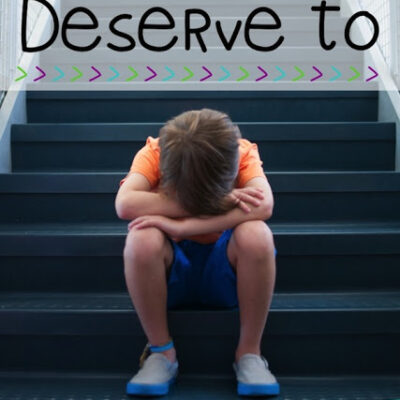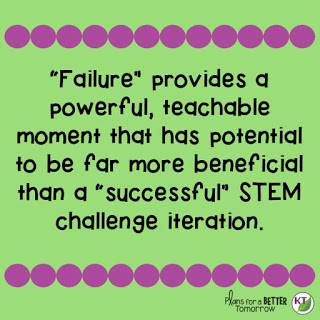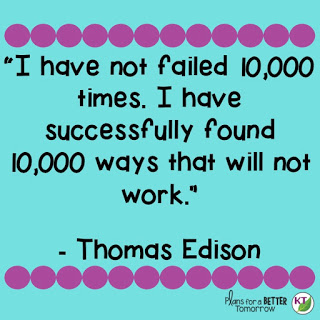We don’t like to be the bearers of bad news. Some of us avoid conflict at all costs, but we do our students a gross disservice when we shield them from challenges in a bid to protect their self esteem. Perhaps they will avoid the temporary sting of defeat when we don’t challenge them, but they will also miss out on the opportunity to develop skills like perseverance and resilience. Those character traits are earned no other way than through struggle. For some high-achievers, these lessons are delayed to when they go off to college for the first time. Spoiler-alert: Disastrous consequences ensue!
I was inspired to write this and create the video above because I want teachers to understand that not all STEM challenges (or science experiments) will go according to plan, and that’s not a bad thing. In fact, “failure” provides a powerful, teachable moment that has potential to be far more beneficial than a “successful” STEM challenge iteration. However, if you prefer to read, you’ll find the video transcribed at the end of this post.
Don’t get me wrong, I’m no sadist! It’s a lot more fun when everything goes to plan. I certainly prefer it that way in my own life! But it’s not realistic to expect smooth sailing all the time, and we have to teach students how to deal with this sometimes harsh reality — so it won’t feel so harsh!
People with a crippling fear of failure are often too scared to take risks that could lead to great things in their lives and in the world. I know; I’m a recovering failure-averse worrier. I spent a lot of time hiding in my comfort zone! Nothing would please me more than to spare students the time and opportunities wasted in life when you are too scared to fail.
If/when a STEM challenge doesn’t turn out as you had hoped, model for students curiosity (rather than frustration, annoyance, or dismissiveness) about what went wrong. You know how when a toddler falls down, he looks to see if you look worried or scared as his cue to cry? And have you noticed when you shrug it off, he does too? This is just like that! Kids learn how to respond to failures from the adults in their lives. If you look upset for your students when a challenge goes badly, they’ll be upset too. If you shrug it off, they will learn to do the same. Of all the things we could teach our kids, that might be the most life-altering.
But shrugging it off doesn’t mean to forget about it and move on to the next thing! After a failed challenge, student teams should find, analyze, and fix failure points. You’ll need to model scientific reasoning and logic as well as a growth mindset attitude. Help them generate ideas of topics to research and approaches to try next. Some of us have failure all tied up with shame in our minds, and that simply shouldn’t be so. Failure is nothing more than data to be analyzed. Imagine if Edison’s team gave up on the light bulb after 9,000 tries!
 So let’s resolve not to bubble wrap our kids. We have to stop feeling like bad guys when we do an activity that induces frustration or challenge for our kids. Let’s show them we believe in their ability to face adversity and develop resilience and problem-solving skills!
So let’s resolve not to bubble wrap our kids. We have to stop feeling like bad guys when we do an activity that induces frustration or challenge for our kids. Let’s show them we believe in their ability to face adversity and develop resilience and problem-solving skills!
And let’s remind ourselves that all kids deserve to fail; for in doing so, they learn how to recover, learn not to be scared to take risks, learn growth mindset skills in practice rather than just theory, and they’ll be better prepared for every other challenge they face in life. Letting your kids fail might just be the most important thing you’ll ever do!
_______________________________________
Here are two fabulous videos to help students understand the value of failure and how they can find & fix failure points in their STEM challenge designs:
Video Transcription
I want to have a little heart-to-heart with you. You saw the title of the
video, “All Students Deserve to Fail.” I have not lost my mind, I
have just thinking a lot about growth mindset and STEM challenges and how they
go hand in hand.
was growing up, fail was truly a four-letter word to me. The first time I ever
really met struggle in school was tenth grade, Algebra 2 Honors. When I got my
first C in that class, I sobbed like a baby. And when that C turned into an
official C on my semester report card, I was inconsolable. In the second
semester, I completely crumbled and officially failed, an F on my report card,
when up until that point I had been a straight A student. It completely changed
my viewpoint of who I was.
aside, I do want to say the teacher of that course, Mr. Bouch, was and is an
awesome teacher, still one of my favorites to this day. I was just totally
unprepared for that class and the high standard he held us to. While my
situation was not as dire, this does remind me of “The Breakfast
Club” and why Brian was in detention. I will link that above, just for
kicks. I know I’m dating myself. I think most people would agree that a fear of
failure holds you back in your life. And it keeps you from taking risks and
doing great things that would ultimately lead to a happier existence. I wish I
had come to understand that a little bit earlier and not lived so much of my
life in fear of failure because in reality, a lot of the best things in my life
have come from something that was initially a failure.
for some of us, we need to gain our wisdom with age. But for our students, if
we can help them figure that out earlier, if we can help them develop a growth
mindset, it’s probably the most important things we’ll ever teach them. And
that’s why I believe all students deserve to fail. And fail early and often. So
they get that practice and they can develop resilience.
that’s why I love STEM challenges so much, because it’s a little compact
experience that is sure to give students experience with frustration, an
initial failure that then the exultation of success.
helping students develop a growth mindset doesn’t happen by accident and it’s
not always easy to do, particularly if you haven’t adopted one yourself.
Because it’s more than just telling students to try, try again.
have to analyze the way your brain works and how you experience failure. Growth
mindset starts with you as the teacher and if you’re like me, that might mean
doing a little bit extra homework to get yourself to a point where you really
are a role model for growth mindset.
I’ll get feedback that expresses some frustration or disappointment that the
challenge didn’t go smoothly or that it was hard for students, and I don’t want
to be dismissive or sarcastic, but challenge is right in the title: “STEM
Challenge.” It’s mean to be difficult.
gonna use one or two examples of feedback I’ve received on a few of my STEM
challenges in order to illustrate my point. Here’s an example. “This was
great except the arrows got to be too heavy with paint. We will have to change
things a little for next year.” Now, I might be reading some into this,
thinking that I see some frustration from the teacher. I’m basing that on the
scores. And here’s my response to that feedback. “For sure. There are many
variables that go into student designs. This is the one of the reasons multiple
iterations are so important in the design process. Students need practice
finding and fixing failure points, similarly to how they practice revising
writing. In fact, there is a great video series I found on YouTube that goes
through all the aspects of the engineering process for kids in short segments.
I blogged about it here.” And don’t worry, I will link this for you before
the end of the video.
it, we all enjoy when all the students’ assigns are successful and everybody’s
happy, that’s much more fun than when students are struggling or upset. I get
it.
when a challenge does not go smoothly, people assume that the reason is that
the challenge was too hard for that age group. But it’s not always that simple.
For example, recently I got an email from someone who said she had tried a
challenge with her young nephew, in preparation for doing it with her class
later in the week. Now there is an age difference between the nephew and the
class. The nephew is younger; the class was older. It went very well with the
nephew, and then the students in her class had a much harder time with it.
After every challenge, whether it was successful or not, you should be
analyzing right along with your students, what went well, what didn’t go well,
what are the problems that could be solved with tweaks of the criteria
constraints list, with the materials used with the time allotted, versus what
can students do with their own designs in order to improve them.
then as often as you can, you need to actually give them that second iteration,
in order to improve their designs. If you want them to develop a growth
mindset, you have to give them an opportunity to grow. As you know, I am always
extolling the virtue of multiple iterations. Now I know it’s not practical to
do it on every single challenge, but particularly on challenges where many
students struggle, you’d want to try to make time for it. Okay, now I know I’ve
said this before, but if you’ve never tried doing a second iteration to a
challenge, just do it once. Just try it one time. And I’ll never have to ask
you again because you will be right behind me in the parade for multiple
iterations.
want to share with you some fun feedback I got on another challenge.
“Thank you. My middle school students have loved this. Well, most of them.
Some of my higher students have struggled a little. A few of them ask, ‘Can we
please just write a paper over cellular respiration and photosynthesis?’ Haha,
no.” I so loved this feedback. And here’s my response, “That is so funny.
I actually mention this in one of my YouTube videos. Some high achiever kids
struggle without the roadmap to success. This is such an important experience
for them to have early and often so they learn how to problem solve and build
resilience. It sounds like you and I are totally in sync on that. Thanks for
sharing.” The reason that I wanted to share this feedback is that it takes
me back to the story I started the video with when I was a tenth grade student
failing Algebra 2 Honors and completely devastated by it. I’m really hoping
that doing things like STEM challenges will help students develop a growth
mindset at an earlier age, so that they aren’t so impacted by what really
should’ve been a small setback.
I’m not a sadist. Of course failure is not as much fun as succeeding, but it’s
equally as valuable in terms of what you learn, if not more valuable. So
remember, all students deserve to fail. And you are not a bad guy for giving
them the opportunity to learn how to fail and learn how to bounce back. That’s
a big part of what teachers do. Don’t teach your kids to fear failure either
implicitly or explicitly. Teach them to attempt new things and if those new
things fail, analyze it, try again. Their lives will be richer for it. Of
course remember that STEM challenges are the perfect way to develop your growth
mindset, especially when you use multiple iterations.
written a corresponding blog for this post. And I’m gonna link it in the
description. Make sure you check it out. I’m going to link to the engineering
process, finding and fixing failure points videos, that I referenced earlier,
as well as some other goodies. So check it out. Make sure you don’t forget to
like and subscribe. Next week I’m gonna be back with the first of the Christmas
and Winter STEM challenge walkthroughs, so you won’t want to miss that. See you
next time.






